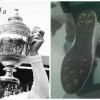By Randy Walker
@TennisPublisher
Professional tennis players a Wimbledon are looking more like young children on skates at an ice rink for the first time.
There has been much discussion at the All England Club about the seemingly more slippery grass surface this year as players are sliding and falling more often than you see a serve-and-volley point.
The most high profile victim of the slippery grass was women’s No. 2 seed Victoria Azarenka, who slipped badly in her first-round match Monday, causing her to withdraw from the tournament Wednesday. Caroline Wozniacki and Julien Benneteau among others are high-profile players to also take major spills on the grass.
Should the grass courts receive more play before the tournament starts to make them less slippery? Should the tennis shoes that the pros wear on the grass courts have harder or longer “dimples” to get a firmer “grab” on the lush green grass?
Back in 1969, when faced with slippery grass court conditions in the U.S. Open final, Rod Laver donned a pair of spiked tennis shoes to close out his sneaker-clad opponent Tony Roche and win his historic second Grand Slam. In this excerpt below from Laver’s memoir THE EDUCATION OF A TENNIS PLAYER ($19.95, New Chapter Press, available here on Amazon.com http://www.amazon.com/The-Education-Tennis-Player-Laver/dp/0942257626/ref=sr_1_1?ie=UTF8&qid=1372252662&sr=8-1&keywords=The+Education+of+a+tennis+player and where ever books are sold), Laver discusses using spikes to help him in the slippery conditions.
That first set was one of the strangest I’ve ever played. I should have won it and deserved to lose it. I got what I deserved and Tony took it 9-7, just took it right away from me after I’d been serving for the set at 5-3. He did it with beautiful backhands. I was sloshing and slipping around, and a couple of times I had asked referee Mike Gibson for permission to put on my spiked shoes. I’d wanted to begin the match in them, but he’d refused. After that game, Mike said all right. It meant all the difference to me.
Tony immediately won his serve in four points, but I felt surer on my feet and I knew I’d get going. Especially when I stopped him two points short of the set to keep even at 6-6.
But I wasn’t so sure when I lost that first set anyway. I’d had a lot of luck during the year, and I wondered if it had run out at last. Although I’d worn spikes here and there throughout my career, the occasions were so rare during my professional days that they took some getting used to. You consciously changed your movements at first. Picked up your feet. No sliding. It was a new sensation until you were re-accustomed to them.
The slight uncertainty of moving in spikes was gone for good in the first game of the second set when I came through with a big serve at the crucial point of the match. With the first set his, and the pressure on me, Tony got me down 30-40 on my serve. One more point and he’d be up a set and a break, a pretty good edge in that mush.
We both knew this was a huge point. He took his time getting ready to return, and I did the same lining up—not overly so, maybe not even noticeable to the crowd, but we had to be right for this one. I was righter. I threw myself into the serve, and sliced it wide to his forehand. It didn’t come back. He barely touched it, and I could tell it pained him to miss the opportunity. You don’t get too many break-point chances on grass— and he didn’t have another.
It wouldn’t be apparent for a while, but the match turned upside down right there. I won the game and began hitting harder and harder as I got surer of my footing. Then I won the next and the next—five straight. From that break-point chance in the first game, Tony managed to win only five of the last 23 games. He came all apart as I wrapped him up, 7-9, 6-1, 6-2, 6-2. Not even a rain delay of a half-hour at the beginning of the third set could rust my concentration or help him pull his together.
Unlike 1962, I had control of myself all through the final match of the Grand Slam. I was never dazed as I had been against Emmo seven years before during a brief case of nerves down the stretch.
Serving match game, I opened with an ace. I knew what I was about, and wasn’t going to let Tony breathe. It was 40-0 when I did try to end with a grand-slamming flourish on a forehand volley. I blew it. A minor disappointment not to be able to score with a put-away as I had on the championship point at Wimbledon.
It fell to Tony to lose it with a forehand that he hit long. Both of us were glad it was over. Afraid to use spikes, he’d been victimized in sneakers, unable to counteract my better shots, including a number of very good lobs. It was one of my best days with the lob, always a useful shot, but even more damaging that day when running was tough.

